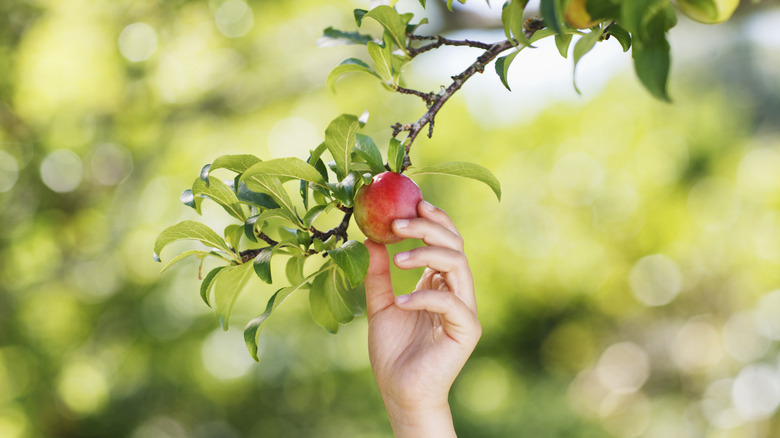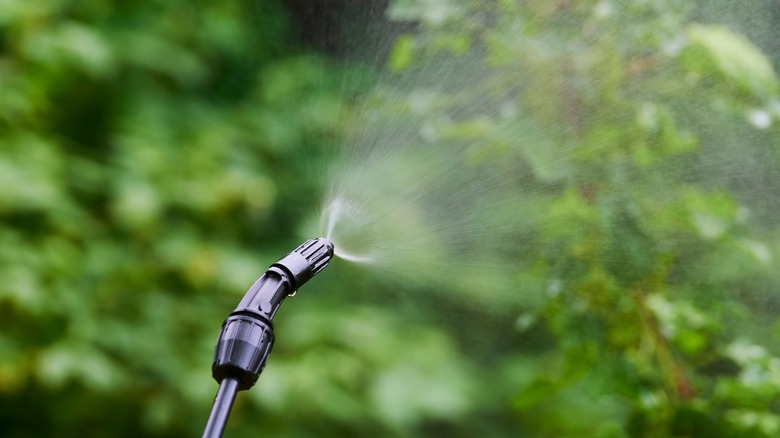Protect Your Fruit Trees From Bacteria And Fungi With A Staple Ingredient
Fruit trees can be an exciting crop to grow in your yard, as they can provide an assortment of culinary opportunities. While this fall harvest is a great boon to look forward to, it's important to provide proper care to your trees throughout the growing season so that the fruit will be healthy and well-developed come autumn. In particular, fruit trees can be vulnerable to both bacterial and fungal infections, as their preference for humidity also benefits these types of microorganisms. If you don't stop these infections, they can cause significant damage to the health of your tree and lead to a reduced crop yield or quality. Nevertheless, you can use a staple household ingredient to help your fruit trees thrive and protect them from infections like blight, root rot, or canker. All you'll need is a simple bottle of vinegar.
Vinegar is an all-natural, non-toxic, and eco-friendly pantry standby that can protect the fruit trees in your backyard due to its antimicrobial properties. Acetic acid is the active ingredient that can help to create an inhospitable environment for any lurking bacteria or fungi. It works by lowering the pH of the tree's tissue and surrounding soil, inhibiting the growth or spread of microorganisms. Moreover, when you use vinegar as a foliar spray, it works as a natural fungicide and bactericide without having to rely on harmful chemicals that can leach into your fruit or kill beneficial pollinators.
How to apply vinegar to your fruit trees
Switching to a vinegar foliar spray or soil drench to protect your fruit trees from bacterial and fungal infections is a great way to help maintain the health of your trees throughout the growing season without having to use traditional chemical sprays that can harm the environment. It's also a super affordable and easy method to use that just requires a standard bottle of vinegar. To get started on a foliar spray, simply mix a tablespoon of vinegar in a gallon of water and then add it to a spray bottle or pump sprayer. Next, use your choice sprayer to evenly coat both the tops and bottoms of the leaves on the tree. Depending on the size of your tree, this may be a complex process that requires a ladder, so exercise caution and safety when tackling higher branches. Nonetheless, it's important to cover the entire tree to prevent any fungal or bacterial infections from beginning or spreading.
If a foliar spray isn't your jam, a soil drench can also be effective. To try this method, simply mix two tablespoons of vinegar with a gallon of water. Then use this solution to water your trees. You can use this application monthly to help ward off bacteria and fungi from your fruit trees. Depending on the size of your tree, you may need several gallons of water to effectively water around the base. Try this method in the morning or late afternoon.
Cautions for this method
Choosing to use vinegar in your garden to protect your fruit trees from bacteria and fungi may be a great option for your plants, though it's important to proceed with some considerations in mind before starting. Vinegar is highly acidic and excessive applications or high concentrations can damage your fruit trees, so it's essential to dilute the vinegar appropriately before using it on your trees so that you don't accidentally damage them in your efforts to protect them. Should you find that the initial application isn't effective, it may be best to contact a local nursery for advice on how to proceed with protecting your trees before reapplying your vinegar spray or drench.
On a similar note, while vinegar is especially effective at tackling harmful bacteria and fungi, it can also harm beneficial bacteria and microorganisms in the soil and on the tree's surface. Therefore, over-application can lead to unintended consequences like soil degradation. If you happen to live in a particularly wet climate, it can be confusing as to how to proceed, because the frequent rain can actually wash away much of the applied vinegar solutions. Knowing how often or how much to apply in this case may be difficult. Checking with local nurseries is a good idea, as they will have the best advice on how to protect trees in your climate. Monitoring the response from your trees is also a great place to start.

